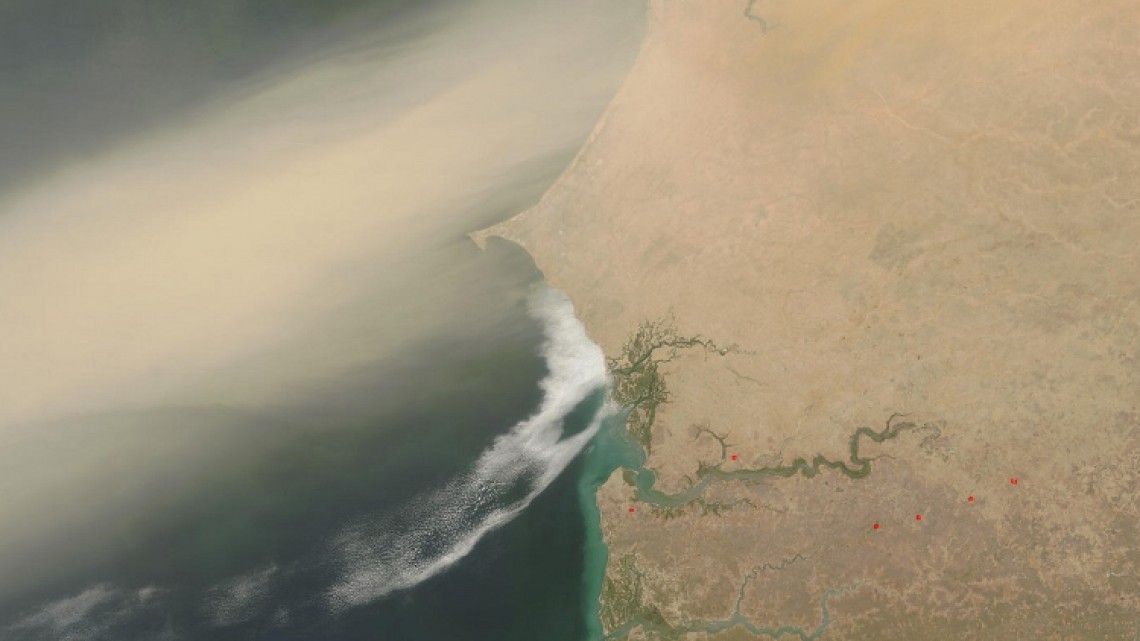
This satellite image shows a large dust plume blowing off the Sahara Desert and out over the Atlantic Ocean.
NASA-Cornell collaboration will study desert dust's impact on climate from space
By David Nutt
Because deserts are located in remote regions with inhospitable conditions, they are notoriously difficult to study, especially when assessing their effect on climate change. A new $60 million collaboration between NASA and Cornell University, with contributions from other universities and labs, solves that problem by traveling even farther afield: to space.
The “Earth surface Mineral dust source InvesTigation” project, or EMIT, pairs NASA technology with Cornell research to pursue new science with an advanced instrument mounted on the International Space Station aimed at desert regions around the world. Using imaging spectroscopy methods, the instrument will measure the soil and mineral composition of desert dust – also known as mineral aerosols – so models built by Cornell scientists can determine how this dust is affecting the climate.
Mineral aerosols are soil particles suspended in the atmosphere after being kicked up from arid, unvegetated regions that have strong winds. The color, size and chemistry of these aerosols can have a range of effects on atmospheric radiation – that is, energy that Earth either absorbs or emits. For example, clear quartz dust is known to cool the climate by reflecting sunlight, while iron oxide dust, which is dark red, warms it through sunlight absorption.
In recent years, Natalie Mahowald, professor of earth and atmospheric sciences and deputy principal investigator on the project, has worked with her students to create models of desert dust and study its different climate and health impacts. However, their research has been hindered by a lack of good data sets.
“NASA has been developing new spectrometers that produce detailed maps of soil composition, which is exactly what we need,” said Mahowald, who serves as faculty director of environment for the Atkinson Center for a Sustainable Future. “We’ll take these maps and then model the distribution of the dust, as well as the different chemical components. From that, we can calculate whether the dust is warming or cooling the planet. It’s a convergence in the development of the technology and the developing of the science questions that make this a really compelling project.”
Deserts are an ideal application for this technology, Mahowald said, because the lack of cloud cover makes them easy to observe from space. And the project is particularly relevant because the amount of desert dust in the atmosphere is increasing, possibly due to human activity or climate change causing increased aridity.
“Desperation is a key ingredient of our current estimates of dust composition. We are limited by sparse measurements of soil mineral composition, so we optimistically extrapolate these to arid regions throughout the entire globe,” said Ron Miller, a climate scientist at the NASA Goddard Institute for Space Studies and Columbia University. “EMIT will provide a million times more measurements, giving us for the first time quantitative and nearly global information about the composition of soil particles that become airborne.”
The bulk of the $60.7 million budget will go toward developing and deploying the imaging spectrometer, which is being built at NASA’s Jet Propulsion Laboratory (JPL) with input from Mahowald’s team and other co-investigators to ensure the instrument can capture all the data they need. A database cataloging the composition of desert regions at a high spatial resolution will also be created. In addition to showing the impact desert dust has on the climate, these data will also be useful for understanding how desert dust fertilizes oceans and terrestrial ecosystems and contributes to the melting of snow and ice. And the data will help scientists study changes in chemistry in the atmosphere.
Research performed by Mahowald’s former graduate student, Rachel Scanza, M.S. ’14, Ph.D. ’16, was instrumental in getting the new project off the ground, Mahowald said. Most climate models assume that dust and soils are homogeneous in composition globally. As part of her thesis at Cornell, Scanza modified existing climate models to allow for the different compositions of dust to be included in the model calculations and showed the importance of these differences for climate impacts. She is now a postdoctoral fellow at a U.S. Department of Energy laboratory.
The new project was selected from 14 proposals considered under NASA’s Earth Venture Instrument initiative, which funds small, targeted investigations that complement the agency’s larger missions.
“We have been developing imaging spectrometers with advanced space technologies to answer new science questions across the solar system for more than two decades. The Moon Mineralogy Mapper imaging spectrometer discovered water/hydroxyl compounds on the illuminated surface of the Moon in 2009,” said Robert O. Green, the principal investigator and senior research scientist at the JPL in Pasadena, California. “The selection of the Earth Venture EMIT investigation provides an important opportunity to advance knowledge of the mineral dust cycle and determine impacts to the Earth system now and in the future.”
David Nutt is managing editor at the Atkinson Center for a Sustainable Future.
Media Contact
Get Cornell news delivered right to your inbox.
Subscribe
